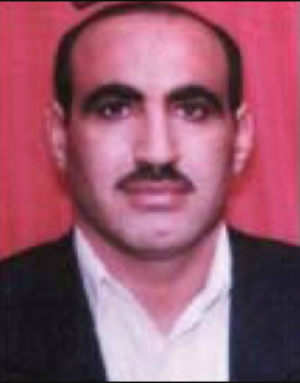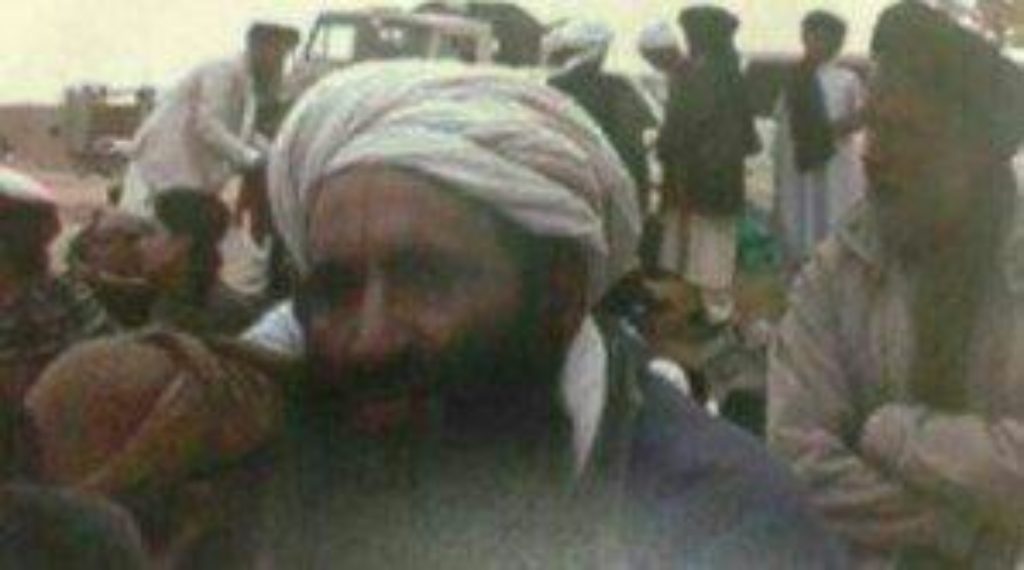
On Feb. 26, jihadist social media sites reported that Abu al Khayr al Masri, one of al Qaeda’s top leaders, had been killed in a US drone strike in Idlib, Syria.
Images of Masri’s car were first posted online by Pieter Van Ostaeyen, a PhD candidate who closely tracks the fighting in Iraq and Syria. One of the pictures, which Mr. Van Ostaeyen obtained from an administrator at the jihadi outfit Al Maqalaat, can be seen above.
Masri’s death was subsequently confirmed in a joint statement issued by Al Qaeda in the Arabian Peninsula (AQAP) and Al Qaeda in the Islamic Maghreb (AQIM) on Mar. 2. The two al Qaeda branches described Masri as a “wise leader” and “teacher,” who instructed young Muslims how to live “with honor” and die as martyrs.
According to AQAP and AQIM, Masri was a “hero” who was killed in a “Crusader drone” strike. The Al Qaeda groups claim that the airstrike is just “one of America’s and the Crusader coalition’s crimes against Islam” and all Muslims. They also offered their condolences to Masri’s family, the Islamic ummah [community of Muslims around the globe], and “our sheikh and emir” Ayman al Zawahiri.
AQAP and AQIM addressed America and its allies directly, saying that the deaths of their “martyrs” only increases their determination to “avenge them.”
From the Egyptian Islamic Jihad to al Qaeda deputy
In July 2016, Masri was identified as Ayman al Zawahiri’s “general deputy.” By that time, US counterterrorism officials had been tracking him for years.
The US Treasury Department designated Masri as a terrorist in Oct. 2005, saying that his real name was Abdullah Muhammad Rajab Abd al Rahman and that he was born in Kafr al Shaykh, Egypt on Nov. 3, 1957. Masri “was responsible for coordinating al Qaeda’s work with other terrorist organizations,” Treasury noted at the time.

US intelligence identified Masri as the chairman of al Qaeda’s management council, according to the Washington Post. Masri also previously served as al Qaeda’s “chief of foreign relations” and in that capacity he was a “liaison to the Taliban.” A dated photo of Masri, first disseminated by the US government, can be seen on the right.**
Masri was originally a senior member of the Egyptian Islamic Jihad (EIJ). In fact, he belonged to the EIJ’s elite shura (or consultation) council. The EIJ, led by Ayman al Zawahiri, effectively merged with Osama bin Laden’s operation during the 1990s, when the two worked hand-in-hand in a series of terrorist plots, including the Aug. 1998 US Embassy bombings.
Masri was tried and convicted in absentia by an Egyptian court as part of the “returnees from Albania case” in the late 1990s. That case was among the largest terror trials to be held during Hosni Mubarak’s tenure as Egyptian president. According to Arabic press accounts of the court proceedings, Masri was identified as one of Zawahiri’s closest advisers back then.
In Dec. 2003, Al-Sharq al-Awsat, a London-based Arabic publication, reported that Masri had served as the head of al Qaeda’s “Sudan station” in 1993. Bin Laden, Zawahiri and their men were stationed in Sudan at the time and Masri was reportedly tasked with forging paperwork for jihadists who wanted to travel around the globe. Masri followed Zawahiri on journeys through Sudan, Yemen and ultimately to Afghanistan in the 1990s.
As one of al Qaeda’s most senior managers, Masri likely had foreknowledge of the 9/11 attacks.*
Sometime after 9/11, Masri fled to Iran. It appears he was held under some form of detention for years. Then, in Sept. 2015, Masri and several other senior al Qaeda figures were reportedly freed from Iranian custody as part of a hostage swap negotiated by AQAP.
As FDD’s Long War Journal reported at the time, however, the details of the al Qaeda leaders’ detention inside Iran are murky. Masri and some of the others were still in Iranian custody as of mid-2010, according to files recovered in Osama bin Laden’s compound. Another letter delivered to bin Laden, authored in early Apr. 2011, noted that Masri’s sons had relocated to Baluchistan.
But Masri’s status was a bit of a mystery. There were several reports in the years since mid-2010 indicating that Masri and the others had been either released already, or the terms of their detention had been relaxed, allowing them to even travel. It is not clear what transpired, exactly, but Masri was certainly integrated back into al Qaeda’s hierarchy by late 2015. And while Iran held some al Qaeda operatives under house arrest, others inside Iran have been allowed to oversee the terror organization’s primary facilitation hub. [See FDD’s Long War Journal report, Senior al Qaeda leaders reportedly released from custody in Iran.]
Then, in July 2016, Masri oversaw one of al Qaeda’s most important moves in Syria to date.
Abu al Khayr al Masri sought to “unify” the rebels’ “ranks”
On July 28, 2016, Al Nusrah Front’s propaganda arm released a short audio message from Masri. Al Nusrah publicly identified Masri as Ayman al Zawahiri’s “general deputy” for the first time.
Masri’s speech paved the way for Abu Muhammad al Julani, Al Nusrah’s emir, to announce that his group was being relaunched as Jabhat Fath al Sham (JFS). Julani also claimed that JFS wouldn’t be tied to any “external entity,” a phrase that some interpreted as indicating a split from al Qaeda.
As FDD’s Long War Journal assessed at the time, however, much of al Qaeda’s own leadership was moved to Syria, meaning al Qaeda itself isn’t “external” to the country. Abu al Khayr al Masri’s death in an American drone strike in Syria late last month underscores that point. Julani also did not renounce his bayat (oath of allegiance) to Zawahiri.
Moreover, al Qaeda has sought to hide its organizational affiliations and the extent of its influence in the Syrian uprising since 2011. In many ways, Al Nusrah’s rebranding was a return to al Qaeda’s original strategy for the Syrian war. That strategy was interrupted by the rise of the Abu Bakr al Baghdadi’s Islamic State. Julani was forced to publicly reveal his loyalty to Zawahiri only after Baghdadi threatened to subsume Al Nusrah Front.
A closer examination of Masri’s message demonstrates that Al Nusrah’s rebranding was indeed the result of a decision made by al Qaeda’s most senior leadership. Masri emphasized that the jihadist ideology had taken root inside Syria. And he explained that al Qaeda wanted to protect the jihadists’ project, as it could lead to the creation of a truly Islamic state, or emirate. This has been al Qaeda’s main goal in Syria for years.
At the outset of his message, Masri claimed that the world was witnessing a “blessed stage of renaissance” in the Islamic ummah. In this “stage of revival,” Masri said, the people are now waging a “jihad of word and weapon” in their revolt against rulers such as Bashar al Assad. Most importantly, from al Qaeda’s perspective, the jihadist ideology was becoming more widely accepted among the people. Masri claimed that “a new generation” of Muslims was being “raised on the jurisprudence” of Islamic law and was learning that jihad is necessary “to preserve” their “religion.”
The ummah has “reached a phase where jihad is expanding and entering Muslim society,” Masri said, according to a translation obtained by FDD’s Long War Journal. “The concept of jihad has changed from being a jihad of an elite few to a jihad of the ummah.”
Masri said that al Qaeda had studied both the “military and political aspects” of “the situation” in the Levant and determined that “every effort” should be made to “continue the jihad.” But they had to prevent their enemies from dividing “the mujahideen” from the “Sunni people.” The “mujahideen” had become a major “force,” administering the “liberated areas” through sharia courts. In addition, Masri explained, the jihadists had set up “public service bureaus” to attend to the peoples’ affairs and in the “next phase” they would “establish an entity,” or government.
Masri then delivered his key line. “Based on my responsibility, we ask the leadership of Al Nusrah Front to proceed with that which safeguards the interests of Islam and Muslims, and protects the jihad of the people of the Levant,” Masri said, according to a translation obtained by FDD’s Long War Journal. Al Nusrah’s leadership should “take the appropriate steps with regard to this issue.”
Masri explained that this “step” was taken as part of al Qaeda’s call on “all mujahideen factions” to “unify” their “ranks to protect our people and our land.” Masri made it clear that unification was necessary to achieve their goal of building “a rightly-guided Islamic government.”
In the event that a Taliban-style government was established, Masri said, al Qaeda’s leaders would be the “first to support this government.” Masri told listeners that his boss, Dr. Ayman al Zawahiri (“our emir and sheikh”), had confirmed this pledge in his own statement.
The audio of Masri’s speech then cut to an excerpt from a message delivered by Zawahiri in Jan. 2014. In it, Zawahiri addressed all of the insurgents fighting against Bashar al Assad’s regime, saying they are the best “hope” for establishing an Islamic state in the heart of the Levant, as well as for “liberating Jerusalem.” Al Qaeda respects and admires “all of you,” Zawahiri said, addressing all of the factions as “brothers.”
“We have always considered that your unity” is “more valued and cherished by us than any other organizational bonds,” Zawahiri said. “Your unity and the unity of your ranks are more important for us than organizational belonging and partisan fanaticism.” Zawahiri implored the mujahideen to “let go” of their “partisan fanaticism,” as their infighting distracts them from the war against their true enemies, including Shiite forces, Russia, and China, all of whom are supposedly colluding with the “Crusader campaign.”
Shortly after Masri’s speech, Abu Muhammad al Julani delivered his own. Echoing Masri’s message, Julani said JFS (formerly Al Nusrah) hoped “to form a unified body, whose basis is Al Shura [consultation],” and which was capable of “uniting the masses of the people of Al Sham.”
Julani, who was dressed in garb similar to that worn by Osama bin Laden, heaped praise on Masri and Zawahiri. “We thank them for their stance, whereby they gave priority to the interests of the people of Al Sham, their Jihad, their revolution, as well as their proper assessment of the general benefits [of] the Jihad,” Julani said. “This noble stance will be recorded in the annals of history. Their blessed leadership has, and shall continue to be, an exemplar of putting the needs of the community and their higher interests before the interest of any individual group.”
Julani added that Masri and Zawahiri had “practically implemented the words of Sheikh Osama bin Laden.”
Julani then quoted bin Laden as saying: “The interests of the ummah take precedence over the interest of any state; the interests of the state take precedence over the interest of any Jama’ah (group); the interests of the Jama’ah (group) take precedence over any individual.”
Hay’at Tahrir al Sham: An attempt to “unify” the rebels’ ranks
As Julani, Masri, and Zawahiri all made clear, al Qaeda has sought to “unify” the rebel groups in Syria. By merging with other groups, al Qaeda could further mask its operations and portray any outside intervention, especially by the US and the West, as part of a conspiracy against Syria’s Sunni population. Indeed, this is exactly how the jihadists have sought to characterize targeted airstrikes against al Qaeda veterans.
While the US government says drone strikes and other bombings are necessary to suppress the al Qaeda threat to the West, the jihadists claim such operations are really intended to disrupt the anti-Assad insurgency. Julani himself said that Al Nusrah’s relaunch as JFS was intended, in part, “to expose the deceptions of the international community, the leaders being the US and Russia, in their relentless bombardment and displacement of the Muslim masses of Al Sham under the pretense of targeting Jabhat al Nusrah, an al Qaeda affiliate.”
In this regard, Al Nusrah’s relaunch as JFS was just the first step in al Qaeda’s plan as of mid-2016. After offering some deliberately vague language about Al Nusrah disassociating from any “external [foreign] entity,” al Qaeda quickly moved to unite JFS with other groups.
However, it wasn’t until Jan. 2017 that a new joint venture, Hay’at Tahrir al Sham (HTS), the “Assembly for the Liberation of the Levant (or Syria),” was announced. HTS includes JFS and several of its allies.
It is likely that JFS and the other groups wanted to announce the creation HTS just days after Masri’s and Julani’s announcements on July 28, 2016.

For example, FDD’s Long War Journal observed that official social media accounts associated with HTS began posting messages in early Aug. 2016. A screen shot of one HTS Twitter account can be seen above. The jihadists operating this account began tweeting on Aug. 3, meaning there was a clear expectation that HTS was going to be announced. Some of the tweets documented the battles then raging in Aleppo.
The delay in the launch of HTS may have been caused by disagreements between JFS and its battlefield partners. In early 2016, jihadists on social media and others reported that Julani had already floated a unification proposal in closed door meetings. But some within Ahrar al Sham, which has modeled itself after the Afghan Taliban, didn’t think Julani’s initiative was sufficient and so they rejected it.
When HTS was announced in January, a powerful faction within Ahrar al Sham, as well as a number of Ahrar’s fighting battalions, defected to the joint venture. These jihadists were led by Abu Jaber, the former head of Ahrar al Sham who was named the first overall leader of HTS. (Julani is the organization’s military chief.) Abu Jaber has adopted the same population-centric approach to waging jihad as Masri and other senior al Qaeda leaders. He is seeking to make jihad even more “popular” in Syria.
However, other factions in Ahrar al Sham refused to join HTS. And in the weeks leading up to the merger in late January, there were multiple reports of infighting between JFS and other rebel groups in northern Syria, including parts of Ahrar al Sham. These disagreements demonstrate that, thus far, there are limits to al Qaeda’s ability to absorb other rebel factions under a common banner.
Still, HTS continues to cooperate with Free Syrian Army (FSA) branded groups, the reconstituted Ahrar al Sham and other Islamist factions. Zawahiri has long advised al Qaeda’s men to adopt this approach in Syria.
Veteran Egyptian jihadists have held key positions in al Qaeda
Nearly thirty years after al Qaeda was founded, veteran Egyptian jihadists who have long been allied with Ayman al Zawahiri continue to play a major role in the organization.
Saif al Adel and Abu Mohammed al Masri, both of whom were also senior figures in the Egyptian Islamic Jihad (EIJ), were reportedly freed by Iran alongside Abu al Khayr al Masri in 2015. Like Abu al Khayr, the circumstances of their detention inside Iran prior to that time is shrouded in uncertainty. Since late 2015, one or both of them may have operated inside Syria.
Another EIJ official and Zawahiri loyalist, Ibrahim al Banna, is a co-founder of Al Qaeda in the Arabian Peninsula. Al Banna was sent to Yemen in the early 1990s to build up al Qaeda’s tribal relations. He was designated as a terrorist by the US State Department earlier this year.
The US air campaign in Syria has targeted legacy EIJ and Gama’at al-Islamiyya (Islamic Group, or IG) leaders who have played major roles in al Qaeda.
In Apr. 2016, the US killed Rifai Ahmed Taha Musa in an airstrike in Idlib. Taha was once the overall leader of the IG. He was a close ally of bin Laden and Zawahiri in the 1990s. Taha and another Egyptian jihadi, Mohammed Islambouli, were top leaders in al Qaeda’s so-called Khorasan Group. Islambouli is still alive and has lived in Turkey for some time.
Ahmed Salama Mabrouk, one of Masri’s and Zawahiri’s old school comrades in the EIJ, sat on Julani’s right hand side as he announced Al Nusrah’s rebranding in July 2016. Mabrouk was killed in early Oct. 2016. The Pentagon explained at the time that he was “one of Al Qaeda’s most senior leaders.”
In early February, the Defense Department announced that still another Egyptian, Hani Haykal (also known as Abu Hani al Masri), was struck down near Idlib. The Pentagon said that Haykal was “one of the founders of Egyptian Islamic Jihad.” Haykal swore an oath of allegiance to bin Laden, and went on to become a top military leader in Ahrar al Sham. Haykal wasn’t the only Egyptian al Qaeda veteran to join Ahrar al Sham either.
Al Qaeda has tried to introduce some of these Egyptians – specifically Saif al Adel, Abu Mohammed al Masri, and Abu al Khayr al Masri – to younger jihadis. One of the ways al Qaeda has done this is by emphasizing the role they played in mentoring prominent figures. Nasser bin Ali al Ansi, a senior AQAP leader and deputy general manager of al Qaeda, was killed in Apr. 2015. In his eulogy for al Ansi, the al Qaeda veteran Khalid Saeed Batarfi specifically mentioned that this trio of Egyptians had groomed him. Hamza bin Laden, Osama’s son, also raised their profile in an audio message released in Aug. 2015. Hamza called for the three, along with others, to be released from custody. But again, they may have already had some freedom by that point.
Abu al Khayr al Masri’s death is a significant tactical blow to al Qaeda. But as the roster above shows, longtime talent continues to lead the organization. And they’ve had ample time to raise a “new generation” of jihadists as well.
*The Defense Department released a transcript of a video recording of bin Laden talking about the 9/11 hijackings in Nov. 2001. “We had notification since the previous Thursday that the event would take place that day,” bin Laden said. “We had finished our work that day and had the radio on. It was 5:30 p.m. our time. I was sitting with Dr. Ahmad Abu-al-((Khair)).”
It is possible that the Dr. Ahmad in question is Abu Khayr al Masri, as Ahmad Hasan Abu al Khayr is one of his known aliases. “Immediately,” bin Laden continued, “we heard the news that a plane had hit the World Trade Center. We turned the radio station to the news from Washington. The news continued and no mention of the attack until the end. At the end of the newscast, they reported that a plane just hit the World Trade Center.” If the man sitting next to bin Laden was in fact Abu al Khayr al Masri, then he was with the al Qaeda founder when news of the 9/11 attacks reached al Qaeda over the radio.
**After Abu al Khayr al Masri’s death was reported, jihadis disseminated another, more recent image of him. The photo was first published by CNN’s Paul Cruickshank. The photo can be seen below:









6 Comments
These Neanderthals all look the same. I’d swear he was a Haqqani.
Warhead misfire, looks like. RFID or a cellphone fix. Nice shot.
Would have preferred a double-tap. Remind them that it’s ALWAYS on.
I think Zawahiri is being very smart. Urging alliances in the Levant and North Africa (Mali).
The era of the “kinder, gentler Al Qaeda” is upon us, the one that John Brennan wants to have last for decades.
Arjuna,
I would be willing to bet you that was a non-explosive warhead dropped on him. Kind of like dropping a cement block on a man’s noggin from the third story.
Correction: Pilots over at Strategy Page are calling it an inert/practice warhead. Nice!
Judging from the damage to the Kia car in the picture we now have a new type of super precision guided munition that causes no collateral damage. It’s a big chunk of concrete.
A lot cheaper than a Hellfire!
If you doubt me ,notice the near misses on the ground beside the Kia.
Arthur Bishop to Abu Khayr al-Masri: “End of game. Bang! You’re dead.”